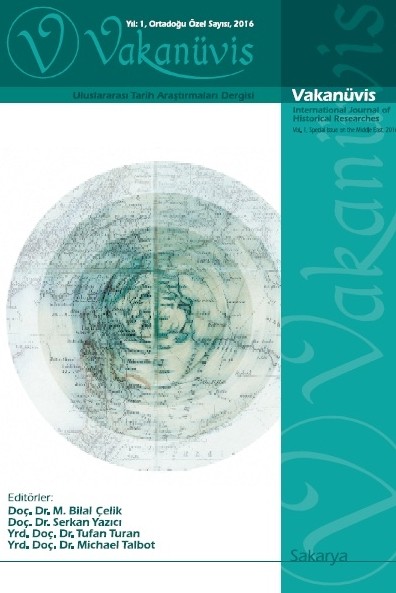Ulus ve Cumhuriyet Gazetelerine Göre Hatay Sorunu ve Hatay'ın Anavatana Bağlanması
Fransa, Türkiye Cumhuriyeti, Suriye, Hatay, Antakya, İskenderun, Sancak Sorunu, Ulus Gazetesi, Cumhuriyet Gazetesi
Hatay Question and the Attachment of Hatay to the Fatherland According to Ulus and Cumhuriyet Newspapers
France, Turkish Republic, Syria, Hatay, Antakya, Alexandretta, Sanjak Problem, Ulus Newspaper, Cumhuriyet Newspaper,
___
- Esin Tüylü Turan, Ulus ve Cumhuriyet Gazetelerine Göre Hatay Sorunu ve Hatay'ın Anavatana Bağlanması, Vakanüvis Uluslararası Tarih Araştırmaları Dergisi, c. 2, s. 1, Sakarya, Mart 2017, ss. 271-299.
- ISSN: 2149-9535
- Başlangıç: 2016
- Yayıncı: Serkan YAZICI
“Hasta Adam” Osmanlı Devleti Karşısında Başarılı Bir İtalyan Diplomasi Örneği: Trablusgarp Savaşı
Şerif Hüseyin’in Mekke Emirliği’ne Atanma Sürecinde Ailesiyle İstanbul’da Geçirdiği Yıllar
Ulus ve Cumhuriyet Gazetelerine Göre Hatay Sorunu ve Hatay'ın Anavatana Bağlanması
Tımışvar Sancağı'nda Tımar Rejiminin Teşekkülü ve İlk Uygulamalar (1555-1556)
Osmanlı Devleti’nde Görev Yapan İspanyol Konsoloslar (1785-1912)
Askerî Mecmua’ya Göre Çanakkale Cephesinde Türk-Alman İttifakı
Türkiye'de Çiftçi ile Köylüleri Topraklandırma Söylemleri ve Uygulamaları (1923-1939)
Nadir’in Şah Eşref Hotekî ile Mücadelesi
Kitap Tanıtımı: M. Serhan Yücel, Çankaya’dan Beştepe’ye Türkiye’de Cumhurbaşkanı Seçimleri
Balkan Dillerinde Doğum ve Ölüm Ritüellerinin Etno-Linguistik Yönleri
